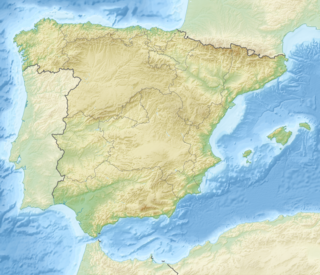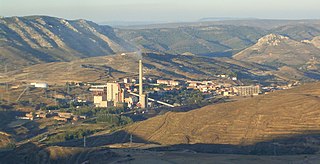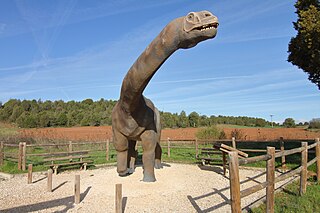 W
WThe Alacón Formation is a geologic formation in Spain in which dinosaur tracks attributed to sauropods and Iguanodontidae have been found.
 W
WThe Arauz Formation is an Emsian fossiliferous stratigraphic unit in Spain. It is a member of the Abadia Group. It is situated in the Province of Palencia, North Spain. It is in the north of Natural Park of Fuentes Carrionas and Fuente Cobre-Montaña Palentina where the Rio Arauz lies. It is from the Devonian of Spain.
 W
WThe Arén Formation or Arén Sandstone is a geological formation in the Tremp-Graus Basin around Arén, Catalonia, Spain whose strata date back to the Late Cretaceous. Dinosaur remains are among the fossils that have been recovered from the formation. The formation dates to the Campanian to Maastrichtian and underlies the Tremp Group.
 W
WThe Artoles Formation is a geological formation in Teruel and La Rioja, Spain whose strata date back to the Early Cretaceous. Dinosaur remains are among the fossils that have been recovered from the formation.
 W
WThe Blesa Formation is a geological formation in Teruel and La Rioja, Spain whose strata date back to the Barremian of the Early Cretaceous. Dinosaur remains as well as eggs are among the fossils that have been recovered from the formation. Along with the fragmentary anhanguerian pterosaur Iberodactylus. While the lower and upper parts of the formation were deposited in a continental setting, the middle portion of the formation is largely nearshore marine, with remains of plesiosaurs.
 W
WThe La Huérguina Formation is a geological formation in Spain whose strata date back to the Barremian stage of the Early Cretaceous. Las Hoyas is a Konservat-Lagerstätte within the formation, located near the city of Cuenca, Spain. The site is mostly known for its exquisitely preserved dinosaurs, especially enantiornithines. The lithology of the formation mostly consists of lacustarine limestone deposited in a freshwater wetland environment.
 W
WThe Calizas de Lychnus Formation is a Maastrichtian geologic formation in northern central Spain. Dinosaur remains diagnostic to the genus level are among the fossils that have been recovered from the formation.
 W
WThe Calizas y margas de Xert Formation or Xert Formation is an Early Cretaceous geologic formation of the Maestrazgo and Galve Basins in central-eastern Spain. The formation is described as a coastal claystone, with indications of a transgressive episode, marked by the transition from marsh facies, with little marine influence, to marine platform facies evidenced by abundant marine invertebrates.
 W
WThe Camarillas Formation is a geological formation in the Teruel Province of Aragón, Spain whose strata date back to the Early Cretaceous. The sandstones, mudstones and conglomerates of the formation, that due to syn-sedimentary faulting varies greatly in thickness from 300 to 800 metres, were deposited in fluvial, deltaic and lacustrine environments.
 W
WThe Castrillo de la Reina Formation is a geological formation in Spain. It is late Barremian to early Aptian in age. It interpreted as a fluvial deposit. It primarily consists of red clay, with ribbon shaped sandstone channel fills. The rebbachisaurid dinosaur Demandasaurus is known from the formation, alongside somphospondylan Europatitan as well as indeterminate small ornithopods, iguanodonts and spinosaurids, the earliest known stem-rhabdodontid (indeterminate) and the lizard Arcanosaurus.
 W
WThe El Castellar Formation is a geological formation in La Rioja and Teruel, Spain whose strata date back to the possibly the Valanginian to the Barremian stages of the Early Cretaceous. Dinosaur remains are among the fossils that have been recovered from the formation.
 W
WThe El Collado Formation is a geological formation in Cuenca, Spain whose strata date back to the Early Cretaceous. Dinosaur remains are among the fossils that have been recovered from the formation.
 W
WThe Enciso Group is a geological formation in La Rioja, Spain whose strata date back to the Early Cretaceous.
 W
WThe Escucha Formation is a geological formation in La Rioja and Teruel provinces of northeastern Spain whose strata date back to the late Aptian to middle Albian stages of the Early Cretaceous. Dinosaur remains are among the fossils that have been recovered from the formation.
 W
WThe Fazaouro Formation is a fluvial-lacustrine sedimentary fill in the northeast of the Province of Lugo, at the site of the prehistoric depositional ranges of a supposed sedimentary glaciation. The area consists of a valley and ridge topography, with a series of small mounts at roughly ninety degrees to each other. The Fazaouro Formation develops through the extinct and extant current basins that fill the valley of Valadouro & Foz.
 W
WThe Forcall Formation is an Early Cretaceous (Aptian) geologic formation in Spain. Dinosaur remains are among the fossils that have been recovered from the formation, although none have yet been referred to a specific genus.
 W
WThe Higueruelas (Spanish) or Higuerueles Formation (Catalan) is a Tithonian geologic formation in the Teruel and Valencia provinces of Spain. Fossil sauropod tracks have been reported from the formation.
 W
WThe La Pedrera de Rúbies Formation is an Early Cretaceous (late Berriasian to early Barremian geologic formation in Catalonia, Spain. The formation crops out in the area of the Montsec in the Organyà Basin. At the La Pedrera de Meià locality, the formation consists of rhythmically laminated, lithographic limestones that formed in the distal areas of a large, shallow coastal lake. It is noted for the exceptional preservation of articulated small vertebrates and insects, similar to that of the Solnhofen Limestone.
 W
WThe Lastres Formation is a geological formation located in Asturias province, northwestern Spain
 W
WThe Piedrahita de Muñó Formation is an Early Cretaceous geologic formation of the Cameros Basin in northern Spain. Fossil theropod tracks have been reported from the formation. Also fossils of Lepidotes sp., Polacanthus sp. and Testudines indet. were found in the formation.
 W
WThe Rupelo Formation is an Early Cretaceous (Berriasian) geologic formation in the Burgos Province of Castile and León in northern Spain. The formation crops out near the municipality Mambrillas de Lara in the northwesternmost part of the Cameros Basin in the Sierra de la Demanda.
 W
WThe Sierra Perenchiza Formation is a late Campanian to late Maastrichtian geologic formation in Spain. Dinosaur remains are among the fossils that have been recovered from the formation, although none have yet been referred to a specific genus.
 W
WThe Tera Group is a geological group in the Cameros Basin and Sierra de la Demanda in Burgos, Spain. The group contains several formations whose strata date back to the Early Cretaceous. Dinosaur remains are among the fossils that have been recovered from the formation.
 W
WThe Tereñes Formation or Tereñes Marl is a Late Jurassic (Kimmeridgian) geologic formation in Asturias, Spain. The grey marls of the formation were deposited in a lagoonal environment at a muddy coast along a temporary inland sea. The lower section of the formation comprises silty and chalky sandstones with desiccation cracks and ripple marks, then becomes a bituminous, prominently ostracod-bearing, pelecypod shell chalk, lime chalk marl and marl. Fossil sauropod tracks have been reported from the formation.
 W
WThe Tremp Formation, alternatively described as Tremp Group, is a geological formation in the comarca Pallars Jussà, Lleida, Spain. The formation is restricted to the Tremp or Tremp-Graus Basin, a piggyback foreland basin in the Catalonian Pre-Pyrenees. The formation dates to the Maastrichtian to Thanetian, thus the formation includes the Cretaceous-Paleogene boundary that has been well studied in the area, using paleomagnetism and carbon and oxygen isotopes. The formation comprises several lithologies, from sandstone, conglomerates and shales to marls, siltstones, limestones and lignite and gypsum beds and ranges between 250 and 800 metres in thickness. The Tremp Formation was deposited in a continental to marginally marine fluvial-lacustrine environment characterized by estuarine to deltaic settings.
 W
WThe Upper Bedoulian Formation is a geological formation in the Murcia Region, Spain whose strata date back to the Early Cretaceous. The marls were deposited in an open marine environment. The lower unit is marly with iron concretions and septaria.
 W
WThe Urbión Group is a geological group in Castile and León and La Rioja, Spain whose strata date back to the Early Cretaceous (late Hauterivian to late Barremian. The formations of the group comprise a sequence of brown limestones in a matrix of black silt, sandstones, claystones and conglomerates deposited under terrestrial conditions, in alluvial fan and fluvial environments.
 W
WThe Vega Formation is a Late Jurassic (Kimmeridgian) geologic formation of the Ribadesella Group in Asturias, Spain. Dinosaur remains diagnostic to the genus level are among the fossils that have been recovered from the formation.
 W
WThe Villalba de la Sierra Formation is a Campanian to Maastrichtian geologic formation in Spain. Fossil dinosaur eggs have been reported from the formation, that comprises gypsiferous, grey, argillaceous mudstones and sandstones, deposited in a floodplain environment. Abundant titanosaurian remains, including Lohuecotitan were found in the formation. More than 10,000 fossil remains of various fishes, amphibians, lizards, dinosaurs, turtles, and crocodiles are also known from the site, one of the richest for the Late Cretaceous in Europe.
 W
WThe Villar del Arzobispo Formation is a Late Jurassic geologic formation in eastern Spain. It is equivalent in age to the Lourinhã Formation of Portugal. It was originally thought to date from the Late Tithonian-Middle Berriasian, but more recent work suggests a Kimmeridigan-Late Tithonian age. The Villar del Arzobispo Formation's age in the area of Riodeva in Spain has been dated based on stratigraphic correlations as middle-upper Tithonian, approximately 145-141 million years old.